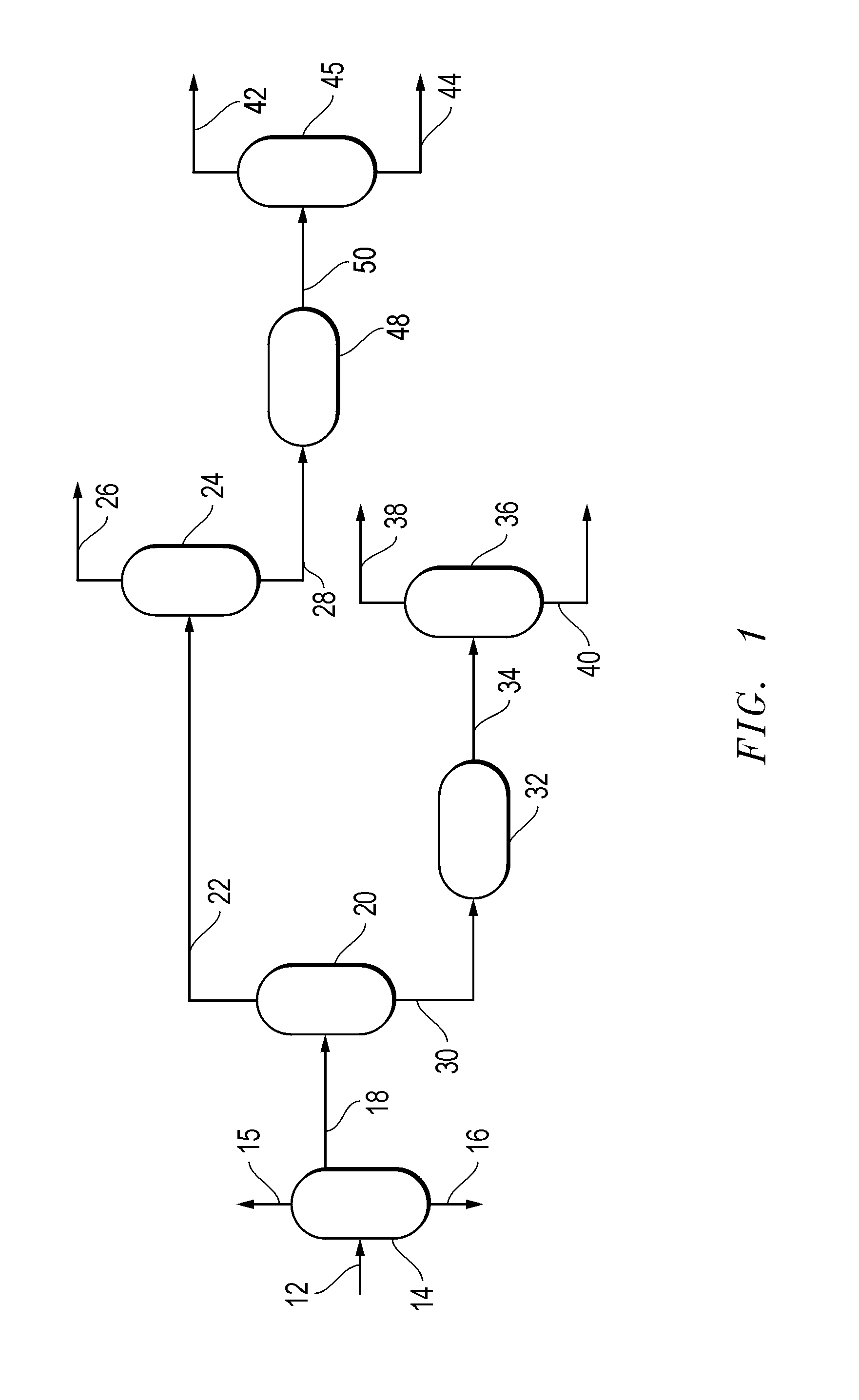Method of treating a hydrocarbon stream comprising cyclopentadiene and one or more diolefins
a technology of cyclopentadiene and diolefins, which is applied in the field of treating a hydrocarbon stream comprising cyclopentadiene and one or more diolefins, can solve the problems of downstream processing problems, inability to meet the requirements of the treatment method, etc., to achieve the effect of increasing reducing the target diolefin concentration, and high purity
- Summary
- Abstract
- Description
- Claims
- Application Information
AI Technical Summary
Benefits of technology
Problems solved by technology
Method used
Image
Examples
example 1
[0086]A simulation was performed using a simulated C5 hydrocarbon stream 18 having the starting composition and feed rate given in the following Table. The simulation subjected a simulated C5 hydrocarbon stream 18 to simulated preseparation conditions. The simulated preseparation conditions comprised a simulated preseparation pressure of 34.5 kPa (5 psig), a preseparator bottoms temperature of about 50.6° C. (123° F.), a preseparator overhead temperature of about 40.6° C. (105° F.), and a mass reflux ratio of about 3.6 with respect to the C5 hydrocarbon stream 18. The simulated preseparation conditions produced a simulated CPD dimerization feedstock 30 having the composition given in the following Table.
[0087]The simulation subjected the simulated CPD dimerization feedstock 30 to simulated dimerization conditions. The simulated dimerization conditions comprised a simulated dimerization feed rate given in the following Table, a simulated dimerization pressure of about 338 kPa (50 psi...
example 2
[0090]In this example, a simulation was performed in which the simulated raw DCPD stream (34) having the starting composition and feed rate shown in the preceding Table was subjected to simulated DCPD separation conditions. The simulated DCPD separation conditions comprised a simulated DCPD separation pressure of about 55 kPa (8 psig), a simulated DCPD separation top operating temperature of about 54° C. (130° F.), a simulated DCPD separation bottom operating temperature of about 170° C. (338° F.), and a simulated DCPD separation mass reflux ratio of about 11.5 with respect to the raw DCPD stream 34. The simulated DCPD separation conditions produced a simulated high purity DCPD product 40 with a simulated DCPD concentration of at least 94.5 wt. %.
example 3
[0091]In this example, a simulation was performed in which a simulated crude isoprene feedstock 22 having the composition and feed rate given in the following Table was combined with a simulated crude PIPS feedstock 38 produced in Example 2 to produce a simulated raw isoprene stream 26 having the composition and feed rate given in the following Table.
[0092]The simulation subjected the combined simulated crude isoprene feedstock 22 to simulated prefractionation conditions. The simulated prefractionation conditions comprised a simulated prefractionation pressure of about 55 kPa (8 psig), a simulated prefractionation top operating temperature of about 45° C. (113° F.), a simulated prefractionation bottom operating temperature of about 68° C. (155° F.), and a simulated prefractionation mass reflux ratio of about 10.1 with respect to the combined crude isoprene feedstock 22 and crude PIPS feedstock 38. The simulated prefractionation conditions produced a simulated raw isoprene stream 26 ...
PUM
| Property | Measurement | Unit |
|---|---|---|
| temperature | aaaaa | aaaaa |
| pressure | aaaaa | aaaaa |
| pressure | aaaaa | aaaaa |
Abstract
Description
Claims
Application Information
 Login to View More
Login to View More - R&D
- Intellectual Property
- Life Sciences
- Materials
- Tech Scout
- Unparalleled Data Quality
- Higher Quality Content
- 60% Fewer Hallucinations
Browse by: Latest US Patents, China's latest patents, Technical Efficacy Thesaurus, Application Domain, Technology Topic, Popular Technical Reports.
© 2025 PatSnap. All rights reserved.Legal|Privacy policy|Modern Slavery Act Transparency Statement|Sitemap|About US| Contact US: help@patsnap.com

